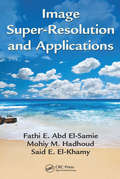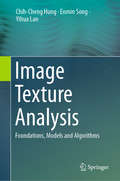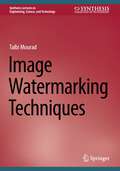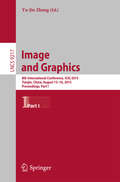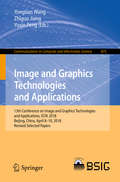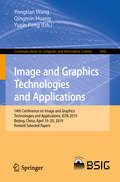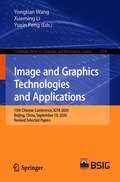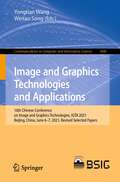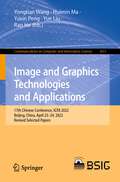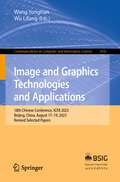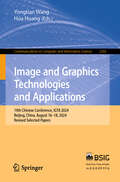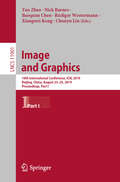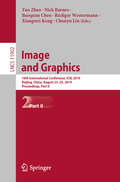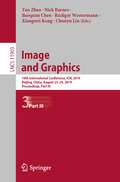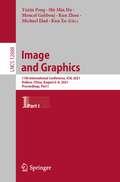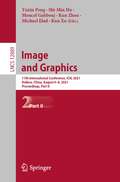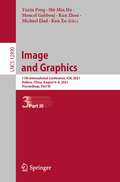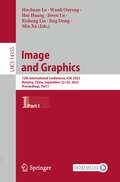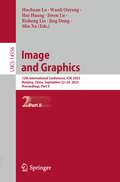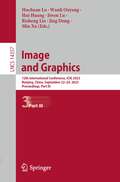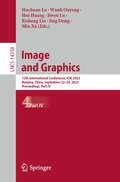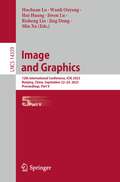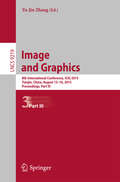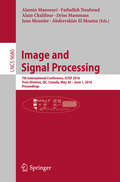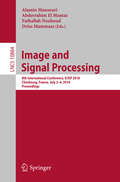- Table View
- List View
Image Super-Resolution and Applications
by Fathi E. El-Samie Mohiy M. Hadhoud Said E. El-KhamyThis book is devoted to the issue of image super-resolution-obtaining high-resolution images from single or multiple low-resolution images. Although there are numerous algorithms available for image interpolation and super-resolution, there's been a need for a book that establishes a common thread between the two processes. Filling this need, Image
Image Texture Analysis: Foundations, Models and Algorithms
by Chih-Cheng Hung Enmin Song Yihua LanThis useful textbook/reference presents an accessible primer on the fundamentals of image texture analysis, as well as an introduction to the K-views model for extracting and classifying image textures. Divided into three parts, the book opens with a review of existing models and algorithms for image texture analysis, before delving into the details of the K-views model. The work then concludes with a discussion of popular deep learning methods for image texture analysis.Topics and features: provides self-test exercises in every chapter; describes the basics of image texture, texture features, and image texture classification and segmentation; examines a selection of widely-used methods for measuring and extracting texture features, and various algorithms for texture classification; explains the concepts of dimensionality reduction and sparse representation; discusses view-based approaches to classifying images; introduces the template for the K-views algorithm, as well as a range of variants of this algorithm; reviews several neural network models for deep machine learning, and presents a specific focus on convolutional neural networks.This introductory text on image texture analysis is ideally suitable for senior undergraduate and first-year graduate students of computer science, who will benefit from the numerous clarifying examples provided throughout the work.
Image Watermarking Techniques (Synthesis Lectures on Engineering, Science, and Technology)
by Talbi MouradThis book investigates the image watermarking domain, analyzing and comparing image watermarking techniques that exist in current literature. The author’s goal is to aid researchers and students in their studies in the vast and important domain of image watermarking, including its advantages and risks. The book has three chapters: image watermarking using data compression; speech modulation for image watermarking; and secure image watermarking based on LWT and SVD.In addition, this book: Investigates the image watermarking domain, analyzing and comparing current image watermarking techniquesIncludes detail on image encryption and mathematical tools used for image watermarkingCovers image watermarking using data compression, speech modulation for image watermarking, and more
Image and Graphics
by Yu-Jin ZhangThis book constitutes the refereed conference proceedings of the 8th International Conference on Image and Graphics, ICIG 2015 held in Tianjin, China, in August 2015. The 164 revised full papers and 6 special issue papers were carefully reviewed and selected from 339 submissions. The papers focus on various advances of theory, techniques and algorithms in the fields of images and graphics.
Image and Graphics Technologies and Applications: 13th Conference On Image And Graphics Technologies And Applications, Igta 2018, Beijing, China, April 8-10, 2018, Revised Selected Papers (Communications In Computer And Information Science #875)
by Yongtian Wang Zhiguo Jiang Yuxin PengThis book constitutes the refereed proceedings of the 13th Chinese Conference on Image and Graphics Technologies and Applications, IGTA 2018, held in Beijing, China in April, 2018. The 64 papers presented were carefully reviewed and selected from 138 submissions. They provide a forum for sharing progresses in the areas of image processing technology; image analysis and understanding; computer vision and pattern recognition; big data mining, computer graphics and VR; as well as image technology applications.
Image and Graphics Technologies and Applications: 14th Conference on Image and Graphics Technologies and Applications, IGTA 2019, Beijing, China, April 19–20, 2019, Revised Selected Papers (Communications in Computer and Information Science #1043)
by Yongtian Wang Yuxin Peng Qingmin HuangThis book constitutes the refereed proceedings of the 14th Conference on Image and Graphics Technologies and Applications, IGTA 2019, held in Beijing, China in April, 2019. The 66 papers presented were carefully reviewed and selected from 152 submissions. They provide a forum for sharing progresses in the areas of image processing technology; image analysis and understanding; computer vision and pattern recognition; big data mining, computer graphics and VR, as well as image technology applications.
Image and Graphics Technologies and Applications: 15th Chinese Conference, IGTA 2020, Beijing, China, September 19, 2020, Revised Selected Papers (Communications in Computer and Information Science #1314)
by Yongtian Wang Yuxin Peng Xueming LiThis book constitutes the refereed proceedings of the 15th Conference on Image and Graphics Technologies and Applications, IGTA 2020, held in Beijing, China in September, 2020.*The 24 papers presented were carefully reviewed and selected from 115 submissions. They provide a forum for sharing progresses in the areas of image processing technology; image analysis and understanding; computer vision and pattern recognition; big data mining, computer graphics and VR, as well as image technology applications. *The conference was held virtually due to the COVID-19 pandemic.
Image and Graphics Technologies and Applications: 16th Chinese Conference on Image and Graphics Technologies, IGTA 2021, Beijing, China, June 6–7, 2021, Revised Selected Papers (Communications in Computer and Information Science #1480)
by Yongtian Wang Weitao SongThis book constitutes the refereed proceedings of the 16th Conference on Image and Graphics Technologies and Applications, IGTA 2021, held in Beijing, China in June, 2021. The 21 papers presented were carefully reviewed and selected from 86 submissions. They provide a forum for sharing progresses in the areas of image processing technology; image analysis and understanding; computer vision and pattern recognition; big data mining, computer graphics and VR, as well as image technology applications. The volume contains the following thematic blocks: image processing and enhancement techniques (image information acquisition, image/video coding, image/video transmission, image/video storage, compression, completion, dehazing, reconstruction and display, etc.); biometric identification techniques (biometric identification and authentication techniques including face, fingerprint, iris and palm-print, etc.); machine vision and 3D reconstruction (visual information acquisition, camera calibration, stereo vision, 3D reconstruction, and applications of machine vision in industrial inspection, etc.); image/video big data analysis and understanding (object detection and recognition, image/video retrieval, image segmentation, matching, analysis and understanding); computer graphics (modeling, rendering, algorithm simplification and acceleration techniques, realistic scene generation, 3D reconstruction algorithm, system and application, etc.); virtual reality and human-computer interaction (virtual scene generation techniques, tracing and positioning techniques for large-scale space, augmented reality techniques, human-computer interaction techniques based on computer vision, etc.); applications of image and graphics (image/video processing and transmission, biomedical engineering applications, information security, digital watermarking, text processing and transmission, remote sensing, telemetering, etc.); other research works and surveys related to the applications of image and graphics technology.
Image and Graphics Technologies and Applications: 17th Chinese Conference, IGTA 2022, Beijing, China, April 23–24, 2022, Revised Selected Papers (Communications in Computer and Information Science #1611)
by Ran He Yue Liu Yongtian Wang Yuxin Peng Huimin MaThis book constitutes the refereed proceedings of the 17th Chinese Conference on Image and Graphics Technologies and Applications, IGTA 2022, held in Beijing, China, during April 23–24, 2022.The 25 full papers included in this book were carefully reviewed and selected from 77 submissions. They were organized in topical sections as follows: image processing and enhancement techniques; machine vision and 3D reconstruction; image/Video big data analysis and understanding; computer graphics; visualization and visual analysis; applications of image and graphics.
Image and Graphics Technologies and Applications: 18th Chinese Conference, IGTA 2023, Beijing, China, August 17–19, 2023, Revised Selected Papers (Communications in Computer and Information Science #1910)
by Wang Yongtian Wu LifangThis book constitutes the refereed proceedings of the 18th Chinese Conference on Image and Graphics Technologies and Applications, IGTA 2023, held in Beijing, China, during August 17–19, 2023.The 35 full papers included in this book were carefully reviewed and selected from 129 submissions. They were organized in topical sections as follows: image processing and enhancement techniques; machine vision and 3D reconstruction; image/video big data analysis and understanding; computer graphics; visualization and visual analysis; virtual reality and human-computer interaction; and applications of image and graphics.
Image and Graphics Technologies and Applications: 19th Chinese Conference, IGTA 2024, Beijing, China, August 16–18, 2024, Revised Selected Papers (Communications in Computer and Information Science #2302)
by Hua Huang Yongtian WangThis book constitutes the refereed proceedings of the 19th Chinese Conference on Image and Graphics Technologies and Applications, IGTA 2024, held in Beijing, China, during August 16–18, 2024. The 36 full papers included in this book were carefully reviewed and selected from 91 submissions. The papers focus on image processing, computer graphics, and related topics, including but not limited to image analysis and understanding, computer vision and pattern recognition, data mining, virtual reality and augmented reality, and image technology applications.
Image and Graphics: 10th International Conference, ICIG 2019, Beijing, China, August 23–25, 2019, Proceedings, Part I (Lecture Notes in Computer Science #11901)
by Yao Zhao Xiangwei Kong Nick Barnes Baoquan Chen Rüdiger Westermann Chunyu LinThis three-volume set LNCS 11901, 11902, and 11903 constitutes the refereed conference proceedings of the 10thth International Conference on Image and Graphics, ICIG 2019, held in Beijing, China, in August 2019. The 183 full papers presented were selected from 384 submissions and focus on advances of theory, techniques and algorithms as well as innovative technologies of image, video and graphics processing and fostering innovation, entrepreneurship, and networking.
Image and Graphics: 10th International Conference, ICIG 2019, Beijing, China, August 23–25, 2019, Proceedings, Part II (Lecture Notes in Computer Science #11902)
by Yao Zhao Xiangwei Kong Nick Barnes Baoquan Chen Rüdiger Westermann Chunyu LinThis three-volume set LNCS 11901, 11902, and 11903 constitutes the refereed conference proceedings of the 10thth International Conference on Image and Graphics, ICIG 2019, held in Beijing, China, in August 2019. The 183 full papers presented were selected from 384 submissions and focus on advances of theory, techniques and algorithms as well as innovative technologies of image, video and graphics processing and fostering innovation, entrepreneurship, and networking.
Image and Graphics: 10th International Conference, ICIG 2019, Beijing, China, August 23–25, 2019, Proceedings, Part III (Lecture Notes in Computer Science #11903)
by Yao Zhao Xiangwei Kong Nick Barnes Baoquan Chen Rüdiger Westermann Chunyu LinThis three-volume set LNCS 11901, 11902, and 11903 constitutes the refereed conference proceedings of the 10thth International Conference on Image and Graphics, ICIG 2019, held in Beijing, China, in August 2019. The 183 full papers presented were selected from 384 submissions and focus on advances of theory, techniques and algorithms as well as innovative technologies of image, video and graphics processing and fostering innovation, entrepreneurship, and networking.
Image and Graphics: 11th International Conference, ICIG 2021, Haikou, China, August 6–8, 2021, Proceedings, Part I (Lecture Notes in Computer Science #12888)
by Moncef Gabbouj Shi-Min Hu Yuxin Peng Kun Zhou Kun Xu Michael EladThis three-volume set LNCS 12888, 12898, and 12890 constitutes the refereed conference proceedings of the 11th International Conference on Image and Graphics, ICIG 2021, held in Haikou, China, in August 2021.* The 198 full papers presented were selected from 421 submissions and focus on advances of theory, techniques and algorithms as well as innovative technologies of image, video and graphics processing and fostering innovation, entrepreneurship, and networking. *The conference was postponed due to the COVID-19 pandemic.
Image and Graphics: 11th International Conference, ICIG 2021, Haikou, China, August 6–8, 2021, Proceedings, Part II (Lecture Notes in Computer Science #12889)
by Moncef Gabbouj Shi-Min Hu Yuxin Peng Kun Zhou Kun Xu Michael EladThis three-volume set LNCS 12888, 12898, and 12890 constitutes the refereed conference proceedings of the 11th International Conference on Image and Graphics, ICIG 2021, held in Haikou, China, in August 2021.* The 198 full papers presented were selected from 421 submissions and focus on advances of theory, techniques and algorithms as well as innovative technologies of image, video and graphics processing and fostering innovation, entrepreneurship, and networking. *The conference was postponed due to the COVID-19 pandemic.
Image and Graphics: 11th International Conference, ICIG 2021, Haikou, China, August 6–8, 2021, Proceedings, Part III (Lecture Notes in Computer Science #12890)
by Moncef Gabbouj Shi-Min Hu Yuxin Peng Kun Zhou Kun Xu Michael EladThis three-volume set LNCS 12888, 12898, and 12890 constitutes the refereed conference proceedings of the 11th International Conference on Image and Graphics, ICIG 2021, held in Haikou, China, in August 2021.* The 198 full papers presented were selected from 421 submissions and focus on advances of theory, techniques and algorithms as well as innovative technologies of image, video and graphics processing and fostering innovation, entrepreneurship, and networking. *The conference was postponed due to the COVID-19 pandemic.
Image and Graphics: 12th International Conference, ICIG 2023, Nanjing, China, September 22–24, 2023, Proceedings, Part I (Lecture Notes in Computer Science #14355)
by Min Xu Hui Huang Jiwen Lu Huchuan Lu Jing Dong Wanli Ouyang Risheng LiuThe five-volume set LNCS 14355, 14356, 14357, 14358 and 14359 constitutes the refereed proceedings of the 12th International Conference on Image and Graphics, ICIG 2023, held in Nanjing, China, during September 22–24, 2023.The 166 papers presented in the proceedings set were carefully reviewed and selected from 409 submissions. They were organized in topical sections as follows: computer vision and pattern recognition; computer graphics and visualization; compression, transmission, retrieval; artificial intelligence; biological and medical image processing; color and multispectral processing; computational imaging; multi-view and stereoscopic processing; multimedia security; surveillance and remote sensing, and virtual reality.The ICIG 2023 is a biennial conference that focuses on innovative technologies of image, video and graphics processing and fostering innovation, entrepreneurship, and networking. It will feature world-class plenary speakers, exhibits, and high-quality peer reviewed oral and poster presentations.
Image and Graphics: 12th International Conference, ICIG 2023, Nanjing, China, September 22–24, 2023, Proceedings, Part II (Lecture Notes in Computer Science #14356)
by Min Xu Hui Huang Jiwen Lu Huchuan Lu Jing Dong Wanli Ouyang Risheng LiuThe five-volume set LNCS 14355, 14356, 14357, 14358 and 14359 constitutes the refereed proceedings of the 12th International Conference on Image and Graphics, ICIG 2023, held in Nanjing, China, during September 22–24, 2023.The 166 papers presented in the proceedings set were carefully reviewed and selected from 409 submissions. They were organized in topical sections as follows: computer vision and pattern recognition; computer graphics and visualization; compression, transmission, retrieval; artificial intelligence; biological and medical image processing; color and multispectral processing; computational imaging; multi-view and stereoscopic processing; multimedia security; surveillance and remote sensing, and virtual reality.The ICIG 2023 is a biennial conference that focuses on innovative technologies of image, video and graphics processing and fostering innovation, entrepreneurship, and networking. It will feature world-class plenary speakers, exhibits, and high quality peer reviewed oral and poster presentations.
Image and Graphics: 12th International Conference, ICIG 2023, Nanjing, China, September 22–24, 2023, Proceedings, Part III (Lecture Notes in Computer Science #14357)
by Min Xu Hui Huang Jiwen Lu Huchuan Lu Jing Dong Wanli Ouyang Risheng LiuThe five-volume set LNCS 14355, 14356, 14357, 14358 and 14359 constitutes the refereed proceedings of the 12th International Conference on Image and Graphics, ICIG 2023, held in Nanjing, China, during September 22–24, 2023.The 166 papers presented in the proceedings set were carefully reviewed and selected from 409 submissions. They were organized in topical sections as follows: computer vision and pattern recognition; computer graphics and visualization; compression, transmission, retrieval; artificial intelligence; biological and medical image processing; color and multispectral processing; computational imaging; multi-view and stereoscopic processing; multimedia security; surveillance and remote sensing, and virtual reality.The ICIG 2023 is a biennial conference that focuses on innovative technologies of image, video and graphics processing and fostering innovation, entrepreneurship, and networking. It will feature world-class plenary speakers, exhibits, and high-quality peer reviewed oral and poster presentations.
Image and Graphics: 12th International Conference, ICIG 2023, Nanjing, China, September 22–24, 2023, Proceedings, Part IV (Lecture Notes in Computer Science #14358)
by Min Xu Hui Huang Jiwen Lu Huchuan Lu Jing Dong Wanli Ouyang Risheng LiuThe five-volume set LNCS 14355, 14356, 14357, 14358 and 14359 constitutes the refereed proceedings of the 12th International Conference on Image and Graphics, ICIG 2023, held in Nanjing, China, during September 22–24, 2023.The 166 papers presented in the proceedings set were carefully reviewed and selected from 409 submissions. They were organized in topical sections as follows: computer vision and pattern recognition; computer graphics and visualization; compression, transmission, retrieval; artificial intelligence; biological and medical image processing; color and multispectral processing; computational imaging; multi-view and stereoscopic processing; multimedia security; surveillance and remote sensing, and virtual reality.The ICIG 2023 is a biennial conference that focuses on innovative technologies of image, video and graphics processing and fostering innovation, entrepreneurship, and networking. It will feature world-class plenary speakers, exhibits, and high-quality peer reviewed oral and poster presentations.
Image and Graphics: 12th International Conference, ICIG 2023, Nanjing, China, September 22–24, 2023, Proceedings, Part V (Lecture Notes in Computer Science #14359)
by Min Xu Hui Huang Jiwen Lu Huchuan Lu Jing Dong Wanli Ouyang Risheng LiuThe five-volume set LNCS 14355, 14356, 14357, 14358 and 14359 constitutes the refereed proceedings of the 12th International Conference on Image and Graphics, ICIG 2023, held in Nanjing, China, during September 22–24, 2023.The 166 papers presented in the proceedings set were carefully reviewed and selected from 409 submissions. They were organized in topical sections as follows: computer vision and pattern recognition; computer graphics and visualization; compression, transmission, retrieval; artificial intelligence; biological and medical image processing; color and multispectral processing; computational imaging; multi-view and stereoscopic processing; multimedia security; surveillance and remote sensing, and virtual reality.The ICIG 2023 is a biennial conference that focuses on innovative technologies of image, video and graphics processing and fostering innovation, entrepreneurship, and networking. It will feature world-class plenary speakers, exhibits, and high-quality peer reviewed oral and poster presentations.
Image and Graphics: 8th International Conference, ICIG 2015, Tianjin, China, August 13-16, 2015, Proceedings, Part III (Lecture Notes in Computer Science #9219)
by Yu-Jin ZhangThis book constitutes the refereed conference proceedings of the 8th International Conference on Image and Graphics, ICIG 2015 held in Tianjin, China, in August 2015. The 164 revised full papers and 6 special issue papers were carefully reviewed and selected from 339 submissions. The papers focus on various advances of theory, techniques and algorithms in the fields of images and graphics.
Image and Signal Processing
by Alamin Mansouri Fathallah Nouboud Alain Chalifour Driss Mammass Jean Meunier Abderrahim ElmoatazThis book constitutes the refereed proceedings of the 7th International Conference, ICISP 2016, held in May/June 2016 in Trois-Rivières, QC, Canada. The 40 revised full papers were carefully reviewed and selected from 83 submissions. The contributions are organized in topical sections on features extraction, computer vision, and pattern recognition; multispectral and color imaging; image filtering, segmentation, and super-resolution; signal processing; biomedical imaging; geoscience and remote sensing; watermarking, authentication and coding; and 3d acquisition, processing, and applications.
Image and Signal Processing: 8th International Conference, ICISP 2018, Cherbourg, France, July 2-4, 2018, Proceedings (Lecture Notes in Computer Science #10884)
by Alamin Mansouri Fathallah Nouboud Driss Mammass Abderrahim El MoatazThis book constitutes the refereed proceedings of the 8th International Conference on Image and Signal Processing, ICISP 2018, held in Cherbourg, France, in July 2018. The 58 revised full papers were carefully reviewed and selected from 122 submissions. The contributions report on the latest developments in image and signal processing, video processing, computer vision, multimedia and computer graphics, and mathematical imaging and vision.
